By Pedro Palandrani, Andrew Little, analysts with Global X Research
Significant technological advancements and societal shifts occurred during the 2010’s decade. Yet many of these developments became so quickly ingrained in our daily lives that they often went relatively unnoticed, and their impact all but forgotten. Over this next decade, the 2020’s, we expect similar rapid and meaningful advancements to occur. Moore’s law suggests that over a ten-year period, semiconductors will advance by 32 times, bringing about mesmerizing innovation in the digital age that should not only change technology, but society, as well. In this piece, we review the technological advancements over the last decade and anticipate what revolutionary changes may be in store for us over the next 10 years.
The 2010’s: A Decade of Disruption
Mobile upgraded from 3G to 4G networks
- What changed? 3G networks introduced a new age of calling, texting, and internet connectivity for mobile devices. 4G offered 10x faster speed than 3G networks, increasing download speeds from 1.5 Mbit/s to 15 Mbit/s.1 For perspective, this reduced the download time for an 800MB movie from 5 hours to 43 seconds. This improvement made 4G a foundational technology for a range of mobile applications that pried users away from their desktops and let them stream music and videos, shop on e-commerce sites, and use social media, all on the go.
- Industries that benefited: Smartphone manufacturers, social media, e-commerce, streaming media
- Then and now stat: Daily time spent online on mobile devices increased from 32 minutes in 2011 to 132 minutes in 2019
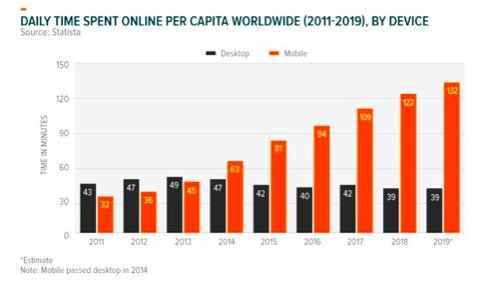
Social Media Brought Our Lives Online
- What changed? In the age of desktop computers, social media was a log of what happened in the past – a collection of experiences uploaded after the fact. As social media shifted to the smartphone, however, it became an instantaneous broadcast of life experiences. And it’s not just individuals using these platforms anymore, companies, news organizations, and governments leverage them to rapidly communicate information in real time. In amalgamating these different types of content, social media platforms became one-stop-shops for information, capturing users’ attention and occupying significant amounts of their time. Advertisers took notice and continued to pour spending across social media platforms and search engines: in 2019, digital advertising spending surpassed that of traditional advertising mediums like TV and radio.2
- Industries that benefited: Social media, online search platforms
- Then and now stat: The number of global social media users increased from 970 million people in 2010 to 2.96 billion in 2020.3
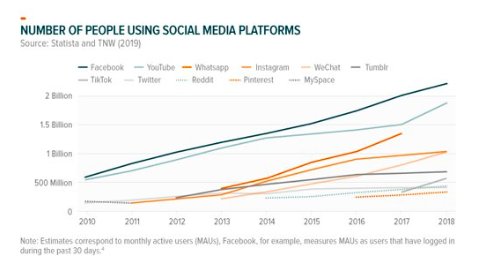
The Dawn of Genomics and Precision Medicine
- What changed? Precision medicine, also commonly referred to as personalized medicine, uses patients’ genetic information to determine the most suitable treatment option for illness and to proactively identify health risks. As genomic sequencing costs rapidly fell, computing power increased, biotech research advanced, and precision medicine transitioned from an idea to a reality. Developments like the CRISPR-Cas9 approach to gene-editing introduced new efficient and reliable ways to make precise, targeted changes to the genome of living cells. In practice, this means editing or removing portions of DNA that present health issues. In 2019, such technology showed promise in treating blood disorders like sickle-cell and other genetic conditions like muscular dystrophy. According to some, CRISPR technology could correct up to 89% of disease-causing genetic variations in the future.5
- Industries that benefited: Biotechnology, gene editing, genetic diagnostics
- Then and now stat: Since CRISPR-Cas9’s 2012 discovery, the genetic editing technology became an intensive research field as is evident by the upward trend of medical journals discussing Cas9.
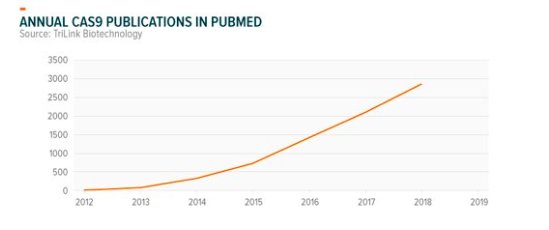
Electric vehicles (EVs) became competitive with internal combustion engine (ICE) vehicles
- What changed? EVs started to pose a legitimate threat to ICEs, particularly within the luxury segment, as technological improvements aided performance and falling battery costs broadened the potential market. Bloomberg NEF estimates that lithium-ion battery prices fell by approximately 90% over the course of the decade.6 Traditionally, batteries represented over 50% of an EV’s total cost, but recent years have seen batteries fall closer to 30%, enabling EVs to be sold at lower prices that are conducive to mass-adoption.7 Today, EVs are close to reaching the estimated cost-parity point with internal combustion engine (ICE) vehicles.
- Industries that benefited: Lithium miners, battery manufacturers, EV Original Equipment Manufacturer (OEMs)
- Then and now stat: There were barely any EVs on US roads in 2010. By the end of the decade, though, there were over 1 million of them.

AI and Big Data Took Off
- What changed? Payments, social media views, online searches, and app usage all leave an extensive digital trail, creating gigabytes of data for each user. With the emergence of artificial intelligence algorithms, these large datasets are sifted through to spot patterns and create instructions that optimize search engines, target advertisements to individuals, or offer real-time directions. As data has become more prolific, AI has continued to learn and advance its capabilities. In 2018, for example, language processing AI outperformed top humans at Stanford on a reading and comprehension test.8
- Industries that benefited: Social media, search engines, e-commerce
- Then and now stat: In 2010, 2 zetabytes of data was created globally, with only 9% of that data available in a structured format (i.e. data that has been organized or indexed for easier referencing). By 2019, annual data volumes reached 41 zetabytes with over of it being 13% structured.9
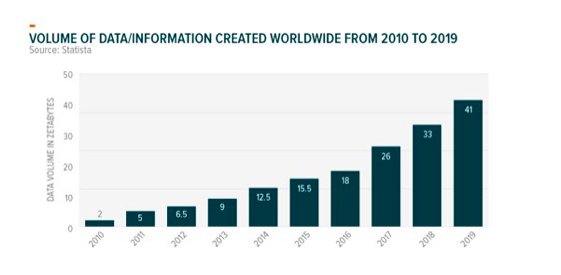
Data storage moved to the cloud
- What changed? Historically, enterprises and consumers stored data and software locally on desktop hard-disks or distributed to on-site servers. But as datasets grew more complex and faster network connections facilitated the rapid transfer of data over the internet, off-premises storage and web-based software programs became more desirable. Cloud-based storage, for example, offers easily scaled data capacity, while allowing for remote and more flexible access across myriad devices. Cloud computing enables firms to conduct critical business functions, ranging from to accounting and HR management, through secure and streamlined digital environments. The software industry, too, migrated from physical CD-ROMs to the software-as-a-service business model, where companies collect subscription revenues and are able offer real-time software updates, remote access, and centralized data storage.
- Industries that benefited: Software-as-a-service (SaaS), Platform-as-a-service (PaaS), Infrastructure-as-a-service (IaaS), data center REITs
- Then and now stat: In 2010, over 90% of data was held in local servers. By 2019, public cloud storage was expected to take over around 30% of this share.

What to expect for the 2020’s
5G becomes the new wireless standard
5G’s means more than just a faster internet. It proliferates the mass-adoption of connected devices in homes, cities and enterprises, including those involved in agriculture, health care, manufacturing, and infrastructure. Increasingly, these industries rely on connected devices to gather and analyze data, making processes more efficient, reducing downtime, and freeing up time to focus on new products and initiatives.
- More research: How can 5G Accelerate the Internet of Things (IoT)?
- Base technology: 4G
- Requirements: capital, supportive government policies, high frequency spectrum
- Industries we believe will benefit: Connected device manufacturers, semiconductor companies, network providers, as well as technologies that rely on 5G, such as autonomous vehicles, telemedicine, and augmented and virtual reality
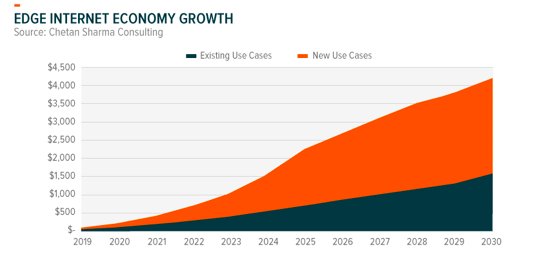
Cloud moves to the edge
The continued decline of computing costs and improvements in network infrastructure and artificial intelligence are key drivers of the emergence of edge computing – data processing conducted locally without transmission across a large network. Some technologies require instantaneous data interpretation and can’t rely on networks with higher latency. Autonomous vehicles, robotic surgery, gaming, and smart factories, for example, can require near simultaneous data transmission. Edge computing reduces latency to 5-10 milliseconds from 25-35 milliseconds for early deployed 5G devices.10 A study estimates the economic impact of edge computing to reach $4.1 trillion by 2030.11
- More research: Cloud Computing: The Digital Infrastructure Powering Today’s Businesses
- Base technology: Cloud computing
- Requirements: Local digital infrastructure, 5G buildout
- Industries we believe will benefit: Cloud infrastructure companies, IoT device makers, AI developers, smart factories, streaming gaming, autonomous vehicle platforms, surgical robots
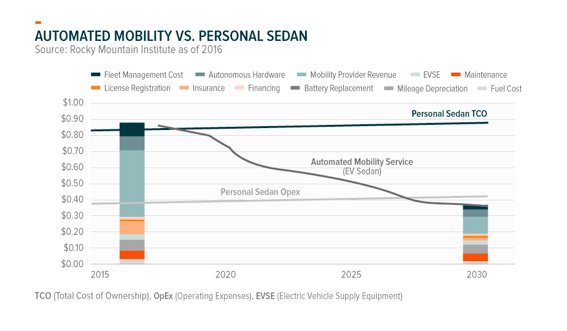
Transportation goes electric, autonomous, and shared
Shared autonomous and electric vehicles are expected to cost $0.35 per mile by 2030, less than half the cost of owning a personal sedan ($0.88 per mile).12 By 2030, new car models equipped with self-driving technology are expected to be commonplace. This transition will allow drivers to take their hands off the wheel while their vehicles drive autonomously, or to hail driverless shared robotaxis. Considering that the average American spends 18 days-worth of time driving each year, greater than the average number of vacation days per year (10 days), the productivity and leisure benefits of autonomous vehicles could be enormous.
- More research: The Future of Transportation is Autonomous & Electric
- Base technology: Ride-share platforms, lithium-ion batteries, computer vision
- Requirements: 5G buildout, level 4 and level 5 autonomous software, supportive policies
- Industries we believe will benefit: lithium miners and battery producers, radar and lidar manufacturers, ride hailing platforms, 5G and AI hardware
Robotics enters new industries
Improvements in artificial intelligence and dexterity are the result of advanced 3D vision capabilities and end-of-arm tooling for precise movements. While the auto manufacturing segment remains robotics’ largest end-market, emerging segments like healthcare and hospitality can benefit from smarter, more capable robots that can conduct surgery, check on patients, cook food, or deliver items to hotel rooms. Agriculture will also see a robotics-driven revolution with automated spraying, monitoring, and picking likely resulting in reduced costs and improved crop yields. The global stock of industrial robots is expected to reach 20 million by 2030, representing a 24% CAGR as robots enter more industries.13
- More research: Drivers of Four Key Segments in Robotics and AI
- Base technologies: Factory automation
- Requirements: Enhanced computer vision, advanced materials
- Industries we believe will benefit: Robotics manufacturers, AI chip developers
Omnichannel-commerce: Not a zero-sum game between e-commerce and brick-and-mortar
The separation between e-commerce and brick and mortar retail will blur as digital and physical shopping experiences become one in the same. Augmented reality will give consumers the ability to try on and order clothes from the comfort of their homes, but physical stores with reduced footprints will feature unique consumer experiences, immediate purchases, and try-before-you-buy optionality. Coupled with IoT technologies that track consumer behavior and build datasets around it, and advances in AI, retailers could be able to predict consumer behavior at almost 100% accuracy. We also expect to see e-commerce as a value add for small and mid-sized businesses, providing a medium for them to sell products outside of their locality and giving a means of accessing global consumer-bases.
- More research: E-commerce Growth Has Continued, but Unequally
- Base technologies: Digital payments, social media, e-commerce
- Requirements: Augmented and virtual reality
- Industries we believe will benefit: E-commerce platforms, FinTech, augmented reality
Health care goes digital: AI diagnoses and telemedicine
As the population ages, there will be increasing pressure to reduce costs, improve patient outcomes, and optimize physicians’ time. All of this is possible by leveraging telemedicine and artificial intelligence – two technologies that are set to disrupt health care. Telemedicine offers an alternative solution to in-person doctor visits, providing diagnostic and clinical services to patients around-the-clock, from the convenience of one’s home or workplace. Currently, telemedicine utilization rates remain below 10% in the U.S., but penetration is likely to grow as technology reduces costs and adds convenience.14 Further digitalization of health care will also enable new use cases for AI. Recent developments like AI-driven, real-time MRI interpretation could mean enhanced diagnoses and treatments across other health care verticals, in addition to its use in telemedicine as an AI chatbot for triage or basic medical advice.
- More research: Chipchat: How Conversational AI Will Change Humans and Computers Forever
- Base technologies: artificial intelligence, streaming
- Requirements: connected medical devices (IoT), conversational AI
- Industries we believe will benefit: Cloud computing, big data & AI
Genomics: The potential to cure the previously incurable
Advances in genomics could offer the first realistic opportunity to cure certain illnesses previously deemed fatal. Scientists have identified more than 50,000 genetic diseases caused by a single gene mutation in humans, known as Mendelian diseases. These are likely to be the first diseases treated through gene editing techniques.15 As the medical and scientific communities’ understanding of gene expression and protein pathways improves and genomic sequencing costs continue to fall, we expect a vast increase in the number of tested and proven genomic therapies.
- More research: Genomics: The Next Great Leap in Health Care
- Base technologies: CRISPR-Cas 9
- Requirements: Support from grants, insurance coverage for expensive treatments, big data
- Industries we believe will benefit: Gene therapy, gene sequencing, gene editing, and bio-technology
Conclusion
The 2010’s were a decade of phenomenal innovation, led largely by the transition to mobile and the rise of data, which accelerated the growth of AI, e-commerce, social media, and biotechnology. In the 2020’s, additional foundational changes will take place as data latency shortens and AI algorithms improve. Such progress should enable new technologies to flourish, including autonomous vehicles, conversational AI, the massive internet of things, and augmented and virtual reality. As new technologies are introduced to the marketplace, they will have a profound impact on our lives, workplaces, and even investments as they reshape the economy.
Related ETFs
BOTZ: The Global X Robotics & Artificial Intelligence ETF (BOTZ) seeks to invest in companies that potentially stand to benefit from increased adoption and utilization of robotics and artificial intelligence (AI), including those involved with industrial robotics and automation, non-industrial robots, and autonomous vehicles.
SNSR: The Global X Internet of Things ETF (SNSR) enables investors to access a potential high growth theme through companies at the leading edge of IoT, an approach which transcends classic sector, industry and geographic regions to target this emerging theme. In a single trade, SNSR delivers access to dozens of companies with high exposure to emerging IoT technology.
CLOU: The Global X Cloud Computing ETF (CLOU) seeks to invest in companies positioned to benefit from the increased adoption of cloud computing technology, including companies whose principal business is in offering computing Software-as-a-Service (SaaS), Platform-as-a-Service (PaaS), Infrastructure-as-a-Service (IaaS), managed server storage space and data center real estate investment trusts, and/or cloud and edge computing infrastructure and hardware.
AIQ: The Global X Future Analytics Tech ETF (AIQ) seeks to invest in companies that potentially stand to benefit from the further development and utilization of artificial intelligence (AI) technology in their products and services, as well as in companies that provide hardware facilitating the use of AI for the analysis of big data.
DRIV: The Global X Autonomous & Electric Vehicles ETF (DRIV) seeks to invest in companies involved in the development of autonomous vehicle technology, electric vehicles (“EVs”), and EV components and materials. This includes companies involved in the development of autonomous vehicle software and hardware, as well as companies that produce EVs, EV components such as lithium batteries, and critical EV materials such as lithium and cobalt.
GNOM: The Global X Genomics & Biotechnology ETF (GNOM) seeks to invest in companies that potentially stand to benefit from further advances in the field of genomic science, such as companies involved in gene editing, genomic sequencing, genetic medicine/therapy, computational genomics, and biotechnology.
SOCL: The Global X Social Media ETF (SOCL) seeks to provide investment results that correspond generally to the price and yield performance, before fees and expenses, of the Solactive Social Media Total Return Index.
This article first appeared on the Global X Research blog on February 1.
Photo Credit: Gamaliel Cabana via Flickr Creative Commons
FOOTNOTES
1. Ken’sTechTips, “Download Speeds: What Do 2G, 3G, 4G & 5G Actually Mean?,” Nov 23, 2018.
2. Vox, “Digital advertising in the US is finally bigger than print and television,” Feb 20, 2019.
3. Statista, “Number of global social network users 2010-2021,” Aug 14, 2019.
4. Note: Estimates from Statista correspond to yearly averages (Statista publishes monthly or quarterly figures). Estimates from TNW correspond to the first figure provided for the corresponding year (TNW published an animation with interpolated data). Estimates for Facebook, Twitter, Instagram, Whatsapp, and Pinterest are taken from Statista. All other series come from TNW. TNW does not provide details regarding their underlying sources but our analysis suggests their estimates are consistent with primary sources and reports such as company earnings press releases, official company websites, and published articles. Statista uses monthly active users to measure social media platform usage. Statista specifies “Facebook measures monthly active users (MAUs) as users that have logged in during the past 30 days. Users are counted separately for Facebook and other apps. Statista specifies “Figures do not include Instagram or WhatsApp users unless they would otherwise qualify as such users, respectively, based on their other activities on Facebook.”
5. Bloomberg, “The CRISPR revolution & hyper-personalized medicine,” Jan 15, 2018.
6. BloombergNEF, “A Behind the Scenes Take on Lithium-ion Battery Prices,” Mar 5, 2019.
7. Global X, “What’s Driving the Electric Vehicle, Lithium, and Battery Markets in 2019?,” May 21, 2019.
8. Fenner, “Alibaba’s AI Outguns Humans in Reading Test
9. Bondcap, “Internet Trends 2019,” Jun 11, 2019.
10. Financier Worldwide, “The emergence of edge computing,” Dec 2019.
11. Chetan Sharma Consulting, “The Edge Internet Economy Forecast to be Worth Over $4.1 Trillion,” Aug 21, 2019.
12. Rocky Mountain Institute, “Peak Car Ownership,” 2016.
13. Oxford Economics, “How Robots Change the World,” Jun 2019.
14. Teladoc, “Investor Presentation: Canaccord Growth Conference,” Aug 8, 2019.
15. WIRED, “Gene Editing is Trickier Than Expected—but Fixes Are in Sight,” Feb 28, 2019.
Disclosures:
Investing involves risk, including the possible loss of principal. There is no guarantee the strategies discussed will be successful. International investments may involve risk of capital loss from unfavorable fluctuation in currency values, from differences in generally accepted accounting principles or from economic or political instability in other nations. Emerging markets involve heightened risks related to the same factors as well as increased volatility and lower trading volume. Narrowly focused investments may be subject to higher volatility. There are additional risks associated with investing in lithium and the lithium mining industry. The investable universe for thematic ETFs may be limited. The funds are non-diversified.
Healthcare, Pharmaceutical, Biotechnology and Medical Device companies can be affected by government regulations, expiring patents, rapid product obsolescence, and intense industry competition. The risks related to investing in cloud computing companies include disruption in service caused by hardware or software failure, interruptions or delays in service by third-party data center hosting facilities and maintenance providers, security breaches involving certain private, sensitive, proprietary and confidential information managed and transmitted by cloud computing companies, and privacy concerns and laws, evolving Internet regulation and other foreign or domestic regulations that may limit or otherwise affect the operations of such companies.
Investing in securities engaged in the social media industry include disruption in service caused by hardware or software failure; interruptions or delays in service by third-parties; security breaches involving certain private, sensitive, proprietary and confidential information managed and transmitted by social media companies; and privacy concerns and laws, evolving Internet regulation and other foreign or domestic regulations that may limit or otherwise affect the operations of such companies.
Information Technology companies can be affected by rapid product obsolescence, and intense industry competition. Risks include disruption in service caused by hardware or software failure; interruptions or delays in service by third-parties; security breaches involving certain private, sensitive, proprietary and confidential information managed and transmitted; and privacy concerns and laws, evolving Internet regulation and other foreign or domestic regulations that may limit or otherwise affect the operations.
Carefully consider the Funds’ investment objectives, risk factors, charges, and expenses before investing. This and additional information can be found in the Funds’ summary or full prospectus, which may be obtained by calling 1.888.493.8631, or by visiting globalxetfs.com. Please read the prospectus carefully before investing.
Global X Management Company LLC serves as an advisor to Global X Funds. The Funds are distributed by SEI Investments Distribution Co. (SIDCO), which is not affiliated with Global X Management Company LLC or Mirae Asset Global Investments. Global X Funds are not sponsored, endorsed, issued, sold or promoted by Solactive AG, nor does Solactive AG make any representations regarding the advisability of investing in the Global X Funds. Neither SIDCO, Global X nor Mirae Asset Global Investments are affiliated with Solactive AG.
Shares of ETFs are bought and sold at market price (not NAV) and are not individually redeemed from the Fund. Brokerage commissions will reduce returns. This information is not intended to be individual or personalized investment or tax advice and should not be used for trading purposes. Please consult a financial advisor or tax professional for more information regarding your investment and/or tax situation.


